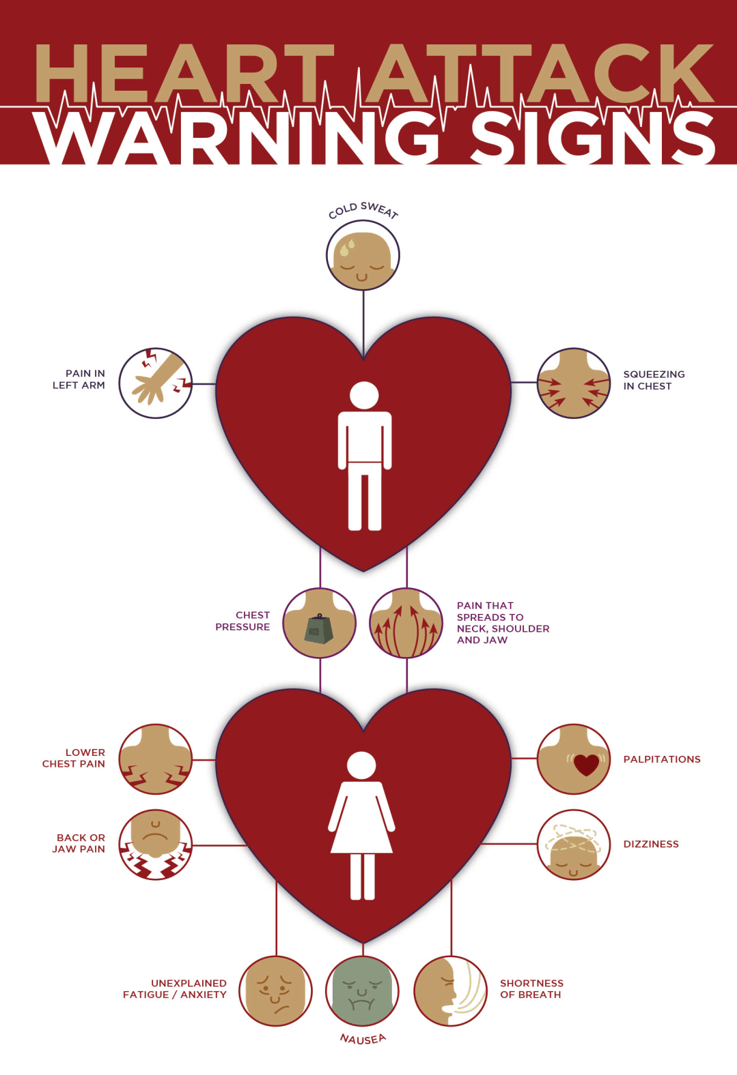FIRST AID ESSENTIALS
CARDIAC
Three types of heart conditions commonly seen in First Aid: Angina, Heart attack and Cardiac arrest.
Angina is usually a warning to a person that they have insufficient blood supply to the heart. This is managed by the casualty administering an oral medication to themselves and observing if the discomfort eases within the first 5 minutes.
Heart attack is a sudden partial or complete blockage in one of the coronary arteries that supply the heart muscle. This causes an interruption to blood supply and a potential life-threatening change to heart rhythm. Chain of survival indicates that time is crucial. If Heart Attack is not corrected in a timely manner there is a risk to serious and permanent heart muscle damage. Every second counts!
Heart attack is different to, but can lead to cardiac arrest.
Cardiac arrest is where there is an electrical malfunction in the heart.
Signs and symptoms
For some victims, sudden cardiac arrest may occur as the first sign of heart attack – however most
experience some warning signs. It is important to note:
- A heart attack can occur in a victim without chest pain or discomfort as one of their symptoms
- The most common symptom of heart attack in a victim without chest pain is shortness of breath
- A victim who experiences a heart attack may pass off their symptoms as ‘just indigestion’.
The casualty may experience one or a combination of these symptoms:
- Pain or discomfort
- Pale skin
- Shortness of breath
- Nausea or vomiting
- Sweating
- Feeling dizzy or light-headed.
Discomfort or pain in the centre of the chest may start suddenly, or come on slowly over minutes. It may be described as tightness, heaviness, fullness or squeezing. The pain may be severe, moderate or mild. The pain may be limited to, or spread to, the neck, throat, jaw, either or both shoulders, the back, either or both arms and into the wrists and hands.
Women, the elderly, people with diabetes and Indigenous people are likely to experience minimal or ‘everyday’ symptoms when experiencing heart attack. These groups should seek urgent medical assessment if they have any warning signs of heart attack, regardless of how mild.

Management
Angina
Angina is managed by the casualty administering an oral medication to themselves and observing if the discomfort eases within the first 5 minutes. Call an ambulance if symptoms are severe, get worse quickly or last longer than 10 minutes.
Heart attack
- Encourage the victim to stop what they are doing and to rest in a comfortable position.
- Call an ambulance if symptoms are severe, get worse quickly or last longer than 10 minutes.
- Stay with the victim until the ambulance or on-site resuscitation team arrives.
- If practical and resources allow, locate the closest AED and bring it to the victim.
- If the victim is unresponsive and not breathing normally, commence resuscitation following the Basic Life Support Flowchart (ANZCOR Guideline 8).
DO NOT leave the casualty to locate an AED.
Cardiac arrest
- Encourage the victim to stop what they are doing and to rest in a comfortable position.
- Call an ambulance
- Seek urgent help and be prepared to administer DRSABCD
- Locate and be prepared to administer an AED
- If the victim is unresponsive and not breathing normally, commence resuscitation following the Basic Life Support Flowchart (ANZCOR Guideline 8).
ARC Guidelines and Related Links
ANZCOR Guideline 8 – Cardiopulmonary Resuscitation
ANZCOR Guideline 9.2.1 – Recognition and First Aid Management of Heart Attack
Test your knowledge
True or false; typical signs of heart attack can be different for males and females?
